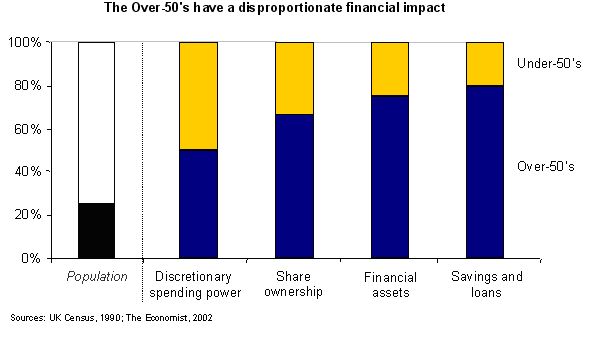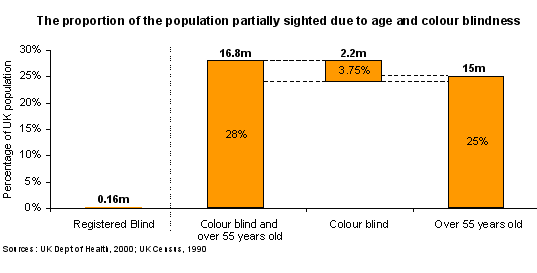The business case
Benefits at a glance
- Reduce legal liability from age and disability discrimination legislation
- Increase revenues from new and existing customers
- Decrease costs from call centres and help lines
- Enhance company reputation and brand
- Speed and ease of use
- Works with company branding
Reduce legal liability
It has come to the attention of governments around the world that the internet has the potential to provide information to all equally. As a result they are introducing legislation to stop discrimination against older and disabled users of online services. Low-vision is counted as a disability, whether it is due to old age or colour blindness, and failure to make online services fully accessible can result in legal action.
Case study
The organizing committee for the Sydney Olympic Games was ordered to pay Au$20,000 because its website was inaccessible to a blind user.
Legal consequences can include:
- An order to comply with regulations
- Compensation payments
- Bad publicity
Running a website that does not meet the requirements of accessibility legislation can leave you open to legal action from a number of quarters: customers, regulators, and pressure groups such as the RNIB and Help the Aged. Using EveryEye is an important and positive step to help reduce your liabilities and conform.
Examples of Accessibility Legislation |
|
Country |
Act |
UK |
Disability Discrimination Act 1995 www.drc-gb.org |
USA |
Section 508 of the Rehabilitation Act Amendments of 1998 www.accessboard.gov/sec508/508standards.htm |
Japan |
Article 8 of the Basic IT Law (Nov 2000) www.kantei.go.jp/foreign/it/it_basiclaw/it_basiclaw.htm |
Increase your revenues
15 million Britons over 55 years old
Commercially and demographically older people have become a very important group. The UK’s 15 million people aged over 55 make up a quarter of the population 1. Additionally, this group is growing by 1.2% per annum, that’s 180,000 more over-55’s per annum, and these new members, the ‘Baby Boomers’, are more connected, more demanding, and wealthier than ever before. Think Mick Jagger not Victor Meldrew!

The Economist reports that “Over-50s own three-quarters of all financial assets and account for half of all discretionary spending power in developed countries. […] In America, they control four-fifths of the money invested in savings-and-loan associations and own two-thirds of all the shares on the stock market” 2. Neglecting to design for older people is a serious commercial error; there are a lot of them and they have a lot of money to spend. Financially, the over-50s punch well above their weight.
1.8 million colour-blind Britons
The colour-blind also form a sizable section of the population.
Colour blindness affects 7% of males and 0.5% of females, or more
than 3% of the population as a whole. Using EveryEye to identify some
basic design errors in the use of colours can turn a website previously
unusable by these 1.8million into one that they come to in place of
the competition.
Decrease your costs
At an average business cost of £2.40 per call* every call to your call centre that can be replaced by access to your website will save your business money. However, if customers find it difficult to access information on your website they will call instead. For the 28% of the population with partial sightedness, an inaccessible website will mean that they are much more likely to call your business instead, or go to the competition. Using EveryEye to help make your site more accessible to these 16.8million UK consumers can have a significant impact in reducing your call centre costs.
Company reputation and brand values
Ensuring that your website is accessible and easy to use by the partially sighted will be seen as a progressive step by consumers and pressure groups. It will help to reinforce brand values such as being customer-focused and community conscious. More critically, making your site accessible will reduce the chance of a negative campaign by pressure groups with regard to accessibility, age, or disability discrimination that could have a negative impact on your company’s reputation and brand.
Saves time. easy to use. more efficient than the alternatives
EveryEye can be called up at the click of a button and provides an instant view of the entire screen from a partially sighted view. One click closes this view. The ability to check an entire screen of content ‘at a glance’ means that inaccessible content ‘jumps out’ at the designer in an instant.
Other approaches to checking a website’s accessibility involve arduous rule-based checklists. Auditing a site by these means takes hours of a designer’s time. Instead, EveryEye can allow the user to make the same judgements in seconds.
Works with your company branding
‘Rule-driven’ alternative approaches restrict your designer’s creativity and adherence to corporate branding. These programs and checklists force the designer to use certain colours, contrasts, fonts sets and sizes, because they are not able to intelligently evaluate each design instance.
In contrast, EveryEye allows the designer to creatively experiment with any design and at the touch of a button see if it is accessible to older and colour blind users. EveryEye promotes ‘design-driven’ accessibility.
EveryEye |
Guideline Based Approaches |
Design-driven accessibility |
Rule-driven accessibility |
View entire screen ‘at a glance’ |
Go through screen with an audit list checking each item |
Allows flexible design – new styles and designs |
Fixed and constraining rules |
Instant & dynamic feedback |
No feedback |
Focused on the end result |
Focused on the code |
Icons and images easily evaluated |
Icons and images can’t be evaluated |
Illustrates the type and degree of impact on accessibility |
Black and white assessment of accessibility |
Allows the designer to see ‘through the eyes’ of the target audience |
Designer can’t envisage how the target audience will see designs |
Design for the entire partially sighted market, including colour blind and the over-50’s |
Design for niche markets such as the fully blind |
References
1. National Census data for England and Wales. Office for National Statistics. 10-10-2002.
2. Economist. Over 60 and overlooked. Economist.com . 8-8-2002.
3. Population Ageing 2002 (Wall Chart). United Nations Population Division, Department of Economic and Social Affairs . 2002.
